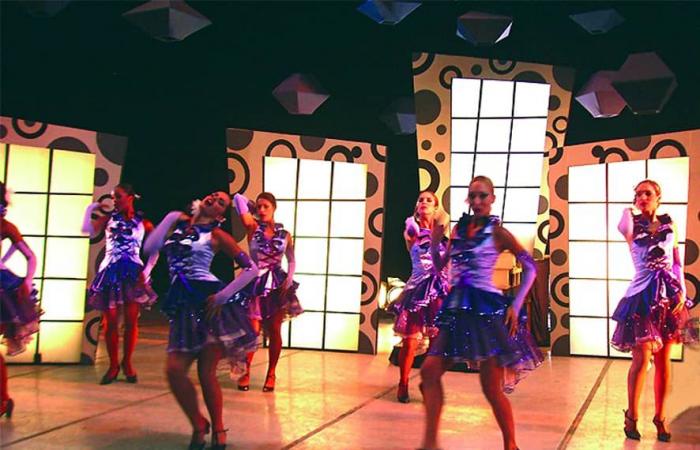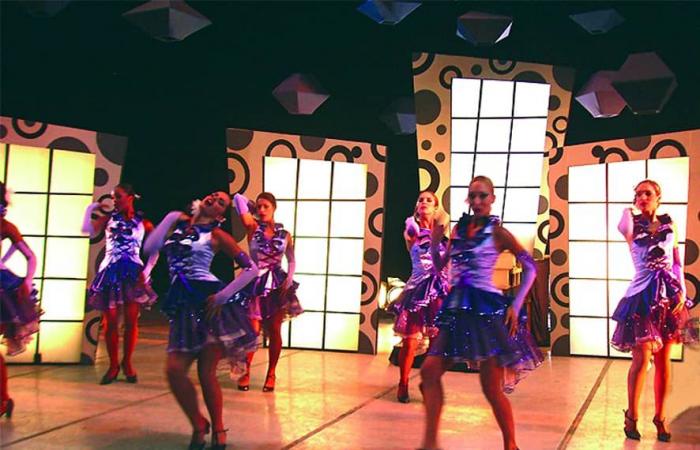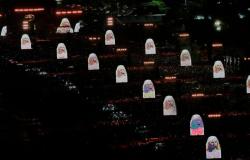The “Ballet of Cuban television” is a Danzaria group founded in March 1963. It is among the first artistic companies of the new culture promoted by the Revolution. Since its inception has accompanied the presentations of the most important events, musical and variety programs, as well as galas and shows organized by the Cuban Institute of Radio and Television (ICRT), both in Cuba and abroad.
Under the initial direction of Alberto Alonso, who was a violin student and the first Cuban to enroll professionally in ballet, the group acquired a distinctive stamp early. Alonso debuted in the ballet “The Blue Danube”, with choreography by Master Nicolás Yavorsky in 1933, and the following year he danced in “Prince Igor”. In 1935 he accompanied Alicia Martínez for the first time in the “Coppélia” ballet, becoming the first partner of who years later would be the great Alicia Alonso, emblematic figure of the universal ballet.
 Back to Cuba in 1941, he was appointed director and teacher of the Dance school of the Musical Pro-art society, as well as the first ballet dancer presented by that institution. There he prepared many works of the Russian Ballet Repertoire and debuted as a choreographer in 1942 with “Preludes” by Liszt, becoming the first Cuban ballet choreographer. During the 1944-45 season, he was the first demi-caractère dancer of the Ballet theater of New York, today American Ballet Theater, and participated in the choreographies of the film “Yolanda”, in Hollywood.
Back to Cuba in 1941, he was appointed director and teacher of the Dance school of the Musical Pro-art society, as well as the first ballet dancer presented by that institution. There he prepared many works of the Russian Ballet Repertoire and debuted as a choreographer in 1942 with “Preludes” by Liszt, becoming the first Cuban ballet choreographer. During the 1944-45 season, he was the first demi-caractère dancer of the Ballet theater of New York, today American Ballet Theater, and participated in the choreographies of the film “Yolanda”, in Hollywood.
I He mparted at the Municipal Conservatory of Havana, where he began to experience a new vocabulary for a ballet that interpreted Cuban feeling, merging the academic with the sensual movements of Afro -Cuban folklore and popular dances. This fusion was evidenced in the premiere of the ballet “before dawn”, in 1947, an innovative work that integrated drums, Conga Carnavalesca and Yorubas rituals with classic steps, marking the beginning of an aesthetic of the Cuban ballet.
He mparted at the Municipal Conservatory of Havana, where he began to experience a new vocabulary for a ballet that interpreted Cuban feeling, merging the academic with the sensual movements of Afro -Cuban folklore and popular dances. This fusion was evidenced in the premiere of the ballet “before dawn”, in 1947, an innovative work that integrated drums, Conga Carnavalesca and Yorubas rituals with classic steps, marking the beginning of an aesthetic of the Cuban ballet.
With that desire to give choreography an authentically national profile, he founded Fernando and Alicia Alonso, in 1950, the national ballet, whose existence was brief. He alternated that work with his work as a choreographer on the nascent Cuban television and in Los Cabarés Montmartre, Sans Souci and Riviera, as well as in the Radiocentro theater. In 1960 he created the “Alberto Alonso Dances set” and in 1962 the “Experimental Dance Set of Havana”, with which he made a tour of Europe that opened the doors of the Olimpia Theater in Paris and several countries of the Eastern European.
 In the 50s he assumed the Ballet Directorate of the newly opened CMQ-Television, where he designed choreographies for musical programs such as “The Cabaré Royalties” and “Thursday of Partagás”. These presentations highlighted dancers with solid technical-artistic training such as Elena del Cueto, Luis Trapaga and Sonia Calero, who incorporated popular dances such as Guaguancó and Rumba, until then marginalized.
In the 50s he assumed the Ballet Directorate of the newly opened CMQ-Television, where he designed choreographies for musical programs such as “The Cabaré Royalties” and “Thursday of Partagás”. These presentations highlighted dancers with solid technical-artistic training such as Elena del Cueto, Luis Trapaga and Sonia Calero, who incorporated popular dances such as Guaguancó and Rumba, until then marginalized.
Alberto Alonso Rayneri, dancer, choreographer and teacher of the National Ballet of Cuba, is recognized as one of the founders of the ballet in Cuba and the main choreographer of the Cuban Ballet School. He was the first Cuban professional dancer who traveled abroad. His international career and his ability to insufflate a tropical air into Cuban ballet, without falling into stereotypes or abandoning academic rigor, make it the most prominent figure of the Cuban choreography of the twentieth century.
Luis Trapaga, with experience in the American Ballet Dance and in Modern North American dance, also explored folklore and Cuban popular dances. He developed new ballet exercises that he called “basic technique.” It was accompanied in that effort to other prominent choreographers such as Roberto Rodríguez and Víctor Cuéllar.
 In his early years, television ballet received young people from dance schools, guided by teachers who offered them opportunities to integrate the dance body. Among them was Ceferino Barrios, as well as two great female figures: Sonia Calero and Elena del Cueto, all of them essential at the beginning of this group. Then there would be new generations that have an imperishable debt with their precursors.
In his early years, television ballet received young people from dance schools, guided by teachers who offered them opportunities to integrate the dance body. Among them was Ceferino Barrios, as well as two great female figures: Sonia Calero and Elena del Cueto, all of them essential at the beginning of this group. Then there would be new generations that have an imperishable debt with their precursors.
Sonia Calero, dancer, rumbera and Cuban choreographer, was one of the best of her time and one of the main exponents of national dances. As a child he demonstrated talent for popular dance, and eleven years old entered the Municipal Conservatory of Havana to study ballet. His entry into the “Ballet CMQ Televisión” marked his true professional debut, giving him a popularity that he would maintain throughout his career.
Under the tutelage of Alberto Alonso, he integrated other groups such as the set of Radiocentro dances and presented himself in various cabarés. His repertoire was broad: academic, concert, neoclassical, experimental and popular. His interpretations were highlighted in the “vignettes” created by Alonso for television, such as “La Calle”, “Quimbisa”, “La Gua-Gua”, “Antonio’s wife”, “The dead man left Rumba”, “El Güije” and “The Solar”, with strong roots in national culture.
 During his television career, he formed a couple with dancers like Víctor Álvarez and Luis Trapaga. “The reluctage”, released in 1957 by the Ballet of CMQ with choreography of Alonso, was a milestone in his career. He also stood out as a teacher in art instructors schools and in the movement of amateur artists. He participated in the Dances of Alberto Alonso and in the experimental dance team of Havana, between 1962 and 1966.
During his television career, he formed a couple with dancers like Víctor Álvarez and Luis Trapaga. “The reluctage”, released in 1957 by the Ballet of CMQ with choreography of Alonso, was a milestone in his career. He also stood out as a teacher in art instructors schools and in the movement of amateur artists. He participated in the Dances of Alberto Alonso and in the experimental dance team of Havana, between 1962 and 1966.
In 1966, he joined the musical theater of Havana and shone in musical comedies. That year, “my lot” was also released, with music by Tony Taño, based on the “El Solar” vignette of 1953. This work became the most successful musical show of the decade. In the same year he entered the National Ballet of Cuba, reaching the rank of first character’s first dancer.
Sonia Calero distinguished itself by its elegance and refinement, far from commercial folklorisms. His Pas de Deux of the broom in “My lot”, along with Roberto Rodríguez, remained as an example of a stylized cubanía. His interpretation of the rumba remains a reference.
Among the most remembered couples on television are “Caruca and Rosendo”, known for their affinity and versatility. Although they also danced for years in Tropicana’s second show, they never left the television ballet. They started their career under the direction of Luis Trapaga and subsequently worked with figures such as Tomás Morales, Francisco González, Félix Ervíti, Joaquín Riviera, Tanya Figueroa, Carmencita Castiñeira, Thania Vázquez and Cristy Domínguez.
The “Ballet of Cuban television” is considered one of the main companies in the country. For many years he was directed by Cristy del Cristo Domínguez Pérez, an outstanding dancer, choreographer and professor, who began his artistic career in 1956. Founder of the experimental dance team of Havana (1962-1965), danced as a soloist in the choreographies of Alberto Alonso, was founder of the Havana Chamber Ballet (1961) and a member of the UNEAC. She was an advisor and jury of the “To dance” program and collaborated with the set of fans.
He also worked as an actress in musical comedies led by Roberto Garriga, star and the “Adolfo Guzmán composition contest.” He was a member of the National Evaluation Commission for Ballet Ballet of National Television.
Possessing an impeccable artistic training and a refined technique, Cristy Domínguez was an example of elegance, style and versatility. Her legacy as a dancer, choreographer, teacher and director has been fundamental to consolidate the ballet of Cuban television as one of the most solid and recognized groups in the country.
For decades, this group has accompanied the main musical and varieties programs, galas and special events of Cuban television. It has been a school and platform for generations of artists who have found on their stage a space for learning and professional growth.
Over time, the Ballet of Cuban television has managed to renew without losing its essence. The integration of new choreographers, the incorporation of contemporary styles and the constant technical and artistic overcoming of its members have been key to their permanence and relevance. He has defended a broad repertoire that goes from academic dances to stylized popular expressions, with a marked national identity.
Today, on the eve of a new anniversary, we celebrate not only the years of existence of this group, but its commitment to Cuban culture, its dedication to dance art and its ability to excite, entertain and represent the most authentic of our roots.
The Ballet of Cuban television is, without a doubt, a bulwark of our television and one of the national scenic dance jewels.







